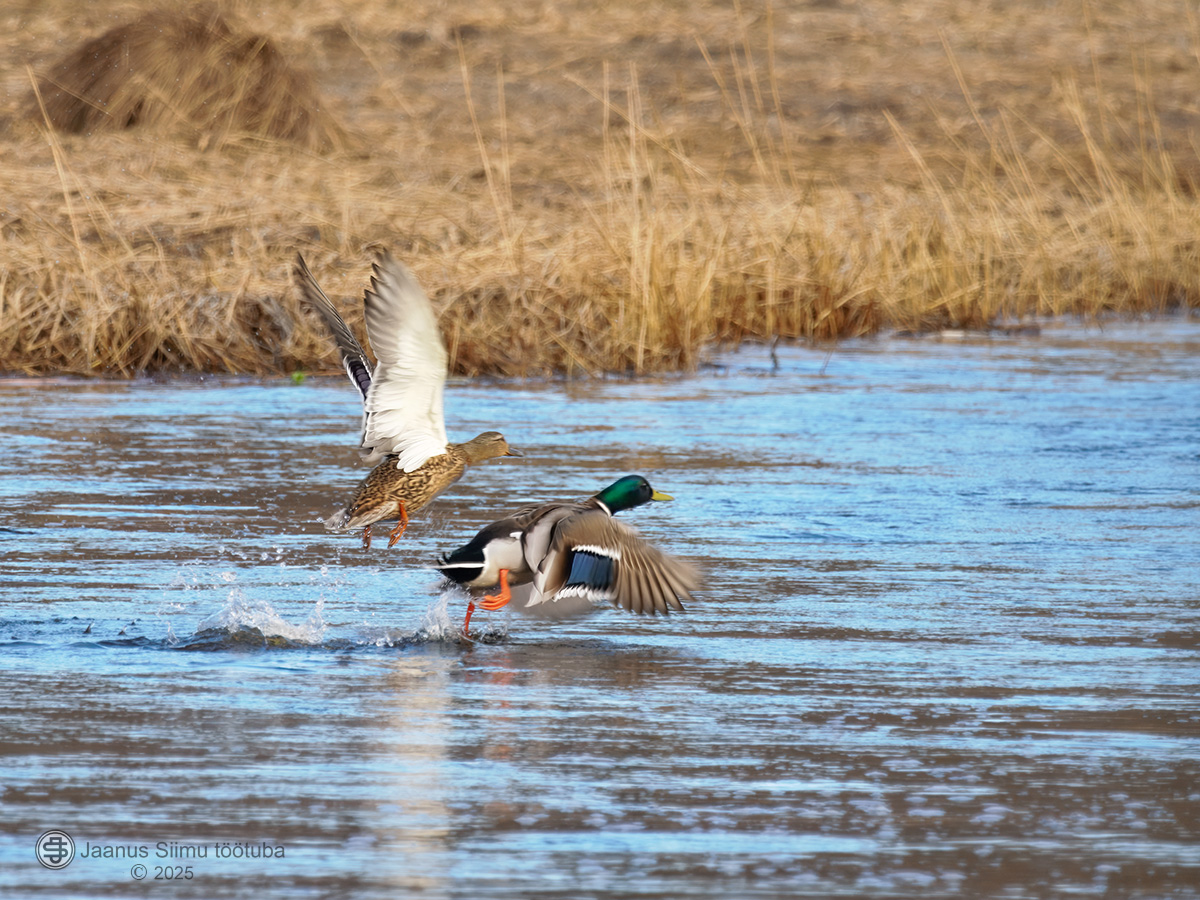
OM-1 Mark II, M.Zuiko Digital ED 300mm F4.0 IS PRO + MC-20, 1/500, f/8,0, ISO 1600.
Möödunud laupäeval kuulsin parte jõe poolt aktiivselt prääksumas. Ega pardid mind otseselt ei huvitanud kuid kuna oli niigi plaanis minna uurima, mida jõeääres näha on, siis hakkasin vaikselt pugema läbi võsa, jõele lähemale. Püüdsin liikuda ettevaatlikult, et sobival võimalusel saaksin parte pildistada. Esimene paar parte, keda mina ei olnud märganud, pani pladinal lendu, ise samal ajal valjuhäälselt pahandades minuga. Teine pardipaar oli umbes saja meetri kaugusel, kes nüüd liigikaaslaste hoiatuse peale tähelepanelikult ringi vaatasid ning kaldalt vette suundusid. Võsa oli sellest läbi pildistamiseks liialt tihe ja ma hiilisin veel mõned meetrid edasi kuid pilt jäi saamata, sest ka need pardid lendasid minema. Hoolimata sellest, et ma olin võsas, mul olid seljas maskeerimisriided ja ma liikusin väga tasahiljukesi, pardid ikkagi märkasid mind. Ega see pildist ilma jäämine mind ei kurvastanud eriti. Pigem pani see seik mind mõtisklema erinevates keskkondades elavate liigikaaslaste erineva käitumise üle. Olen elanud kolmkümmend aastat pisikeses linnakeses, mille südames on väike paisjärv, kus elab neid samu sinikael-parte kümnete kaupa. Linnavurledest pardid inimest ei pelga. Kuna paljudele inimestele meeldib parte seal järve ääres toita siis pigem tulevad pardid ise inimeste juurde, lootuses mõne toidupala nokavahele saada. Ja üldse tunnevad need linnapardid end väga koduselt nii tänavatel kui ka koduaedades. Sellepärast mul puudubki suurem huvi partide vastu, looduses ringi liikudes. Kas ja kui palju mõjutas mind vahetult kogetud luhtunud katse partidele lähedale pääseda kuid ma jõudsin oma mõtisklustes sinnamaale, et tegelikult on sinikael-pardid omas loomulikus elukeskkonnas, metsikus looduses, vägagi ilusad ja huvitavad vaadelda ning pildile jäädvustada. Pühapäeval liikusin taas Navesti jõe kalda lähedal ringi, otsides jõeoru liivastelt nõlvadelt mägra koopaid. Ühele kõrgele kaldapealsele lähenedes, kus minu ees rullus lahti pikalt läbi heinamaa looklev, kevadisest suurveest tulvil jõgi, nägin ühte pardipaari vähemalt kolmesaja meetri kaugusel. Seega olin ma lindudest kolm korda nii kaugel kui olin olnud eelmisel päeval. Mitte ükski lind ega loom ei olnud lähiajal teadustanud minu olemasolust. Kui eile olin ma vaid peene võsa varjus siis seekord olin kaugel suurte puude vahel ja tihedate okste varjus ning loomulikult kaitsevärvi riietuses. Paraku jõudsin ma vaid kaamera sisse lülitada ja linnud kaadrisse saada kui nad juba lendu tõusid. Muidugi võis siin olla ka vaid kokkusattumus ja pardid tõusid lendu mitte minust häirituna, vaid mingil muul, minule märkamatuks jäänud põhjusel. Aga nende reaktsioon ja tegutsemine oli vägagi sünkroonis minu ilmumise ja tegutsemisega. Seekordne mõttelõng viis mind ajas aasta tagasi kui mul oli analoogne kogemus jääkosklatega Saarjõe ääres. Ja edasi mõtisklesin juba, et kõikide metsikus looduses elavate elukate elu on algusest lõpuni üks pidev IQ eksam. Kes eksamil põrub, see sugu jätkata ei saa. See tähendab aga seda, et läbi loomuliku loodusliku valiku jätkavad sugu vaid kõige targemad, osavamad ja tugevamad ning säilib liigi elujõulisus. Seda muidugi seni, kuni inimene omas “tarkuses” ei sekku.
Last Saturday I heard ducks actively quacking by the river. I wasn’t really interested in ducks, but since I was already planning to go explore what there was to see by the river, I started to quietly creep through the bushes, closer to the river. I tried to move carefully so that I could take a picture of the ducks when the opportunity arose. The first pair of ducks, which I hadn’t noticed, took off, while loudly complaining to me. The second pair of ducks was about a hundred meters away, which now looked around attentively at the warning of their fellow ducks and headed for the water from the shore. The bushes were too dense to take a picture through, and I crept a few more meters forward, but I couldn’t get a picture because these ducks also flew away. Despite the fact that I was in the bushes, I was wearing camouflage clothing, and I was moving very slowly, the ducks still noticed me. I wasn’t particularly sad about missing the picture. Rather, it made me think about the different behaviors of our species living in different environments. I have lived for thirty years in a tiny town with a small reservoir at its heart, home to dozens of these same mallards. City ducks are not afraid of people. Since many people like to feed the ducks by the lake, the ducks themselves tend to come to people, hoping to get a piece of food between their beaks. And in general, these city ducks feel very at home both on the streets and in home gardens. That is why I have no greater interest in ducks when they are roaming around in nature. Whether and to what extent the failed attempt I experienced to get close to the ducks directly affected me, but in my reflections I came to the conclusion that in fact mallards in their natural habitat, in the wild, are very beautiful and interesting to observe and photograph. On Sunday, I was again walking around the banks of the Navesti River, looking for badger dens on the sandy slopes of the river valley. Approaching a high bank, where a river, full of spring water and winding through the meadow, unfolded before me, I saw a pair of ducks at least three hundred meters away. So I was three times as far away from the birds as I had been the day before. No bird or animal had recently announced my presence. If yesterday I was only in the shade of a thin bush, this time I was far away among large trees and in the shade of dense branches and, of course, in protective clothing. Unfortunately, I only managed to turn on the camera and get the birds in the frame when they were already taking flight. Of course, it could also have been just a coincidence and the ducks took flight not because they were disturbed by me, but for some other reason that remained unnoticed by me. But their reaction and actions were very much in sync with my actions. This time, the thought took me back a year to when I had a similar experience with goosanders on the banks of a river called Saarjõgi. And then I began to think that the life of all creatures living in the wild is a continuous IQ exam from beginning to end. Anyone who fails the exam cannot continue the species. This means that through natural selection, only the smartest, most skilled and strongest will continue the species, and the viability of the species will be preserved. This is of course as long as humans, in their “wisdom”, do not interfere.
Kui märkate vigu, faktilisi või keelelisi, eesti või inglise keeles, siis palun kirjutage sellest jaanus@suure-jaani.ee If you notice mistakes, factual or linguistic, in Estonian or English, please write about it jaanus@suure-jaani.ee

